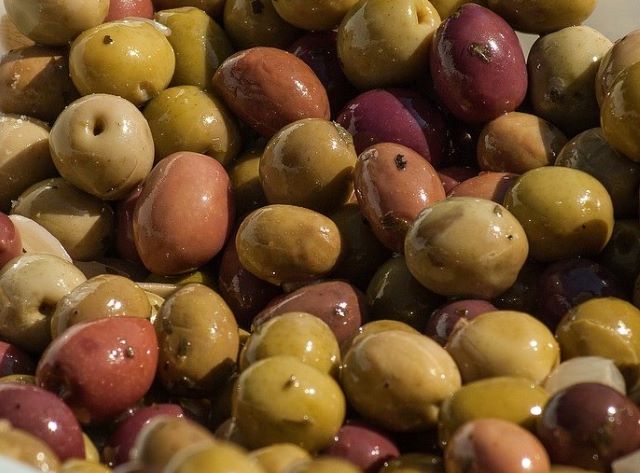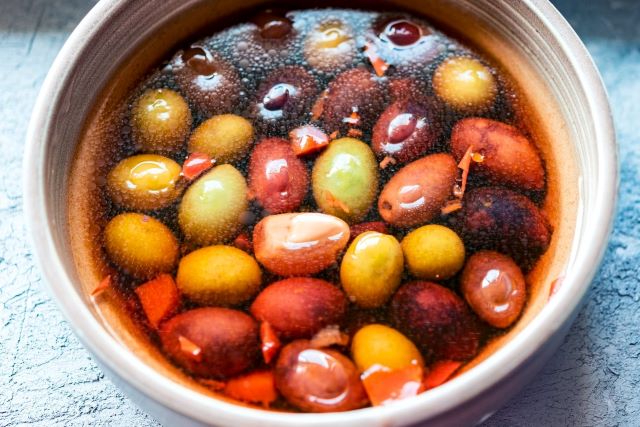Olives. You put them on pizza, toss them in with roasts, and sometimes eat them on their own. No chef’s kitchen is complete without a bottle of olive oil. You lump them in with the rest of the veggies in your meals. But are olives actually vegetables or in fact a fruit?

Much like tomatoes, the debate over whether an olive is a fruit or a vegetable is a heated one. So what’s the truth?
In short, olives are technically fruits. However, because of the differences in terminology, it’s totally ok to call them vegetables and treat them as such.
Not sure what I mean? Read on to find out more!
Table of Contents
The differences in defining fruits and vegetables
You see, the reason that many fruits are often called vegetables is simple: there are two common ways of defining these types of food. One follows botanical definitions, which are most useful for gardeners and scientists.
The other follows culinary definitions. These are better for chefs, nutritionists, and the majority of the population. But what are the differences in these definitions?
The botanical definition of olives

By botanical standards, an olive is a fruit. What makes something a fruit?
A fruit is the (usually edible) seed carrier of a plant. Most fruits grow from flowers on the plant. So, if it grows from a flower on a plant and contains seeds, this means it’s a fruit.
That means many foods commonly called vegetables are fruits. Tomatoes, pumpkins, avocados, cucumbers, peppers, and, yes, olives, among others.
In botanical terms, a vegetable is a much looser category. It’s a broad term used to encompass all of the edible parts of plants that aren’t fruits. This includes stems, leaves, tubers, roots, etc. So something like rhubarb, where you eat the stalk, is a botanical vegetable.
Why is this distinction important? Well, for scientists and gardeners, knowing what part of the plant produces seeds is highly important. Seeds are how many plants reproduce, so if you want to grow more plants, you need to harvest fruits and their seeds.
The pit in the center of an olive is a seed and if planted, it could grow into an olive tree. Meaning olives are fruit, through and through. In fact, they’re part of a family known as stone fruits, which also contain fruits like mangoes, cherries, and peaches.
However, for most chefs and everyday people, this definition isn’t very helpful. So what’s the culinary definition of an olive?
Olives as vegetables

In culinary terms, the way in which most people understand fruits and vegetables, an olive is a vegetable. What makes it such?
Well, olives aren’t sweet like many fruits are. And, while they can and are eaten by themselves, they’re also used cooked with other foods. And their flavor changes significantly when cooked.
We put olives on pizza, in stews, in with our chicken, in some salads, etc. Most fruits wouldn’t go on a pizza (except pineapples, of course).
So, if you’re not looking to grow your own olive trees and just want to enjoy their taste, it makes a lot of sense for you to call them vegetables.
Differences between botanical and culinary definitions
Why do these two different systems of classification exist to define fruit and vegetables? Because people use the information for different purposes.
For gardeners, it’s important to know what foods contain seeds, and which don’t. Personally, I call tomatoes and olives fruits, because I know I can use their seeds to grow more plants.
However, outside of this context, it isn’t important to know whether a food has seeds in it. I also cook a lot, and the culinary classification of fruits and vegetables works much better for kitchen purposes.
In the culinary world, foods are separated based on their taste and use, not necessarily what part of the plant they are. Fruits are usually sweet, soft, juicy, and perfectly delicious on their own. They’re also used a lot in desserts and sweet things.
Vegetables, on the other hand, tend not to be very sweet. While they can be eaten on their own, it’s much more common to eat them with other things. They can often be better.
Many vegetables have tougher skin and flesh, and some even require cooking to be eaten. Even for those that can be eaten raw, cooking will heavily change their texture, flavor, and what they can add to a dish.
Any good chef knows that putting a tomato in a fruit salad is a bad idea. Similarly, putting an olive on a cake probably won’t taste very good.
But cooking with olives as part of a savory dish is incredible. That’s one of the most basic differences between fruits and vegetables in the kitchen, even if it isn’t true 100% of the time: fruits are sweet, and vegetables are savory.
So, when thinking about whether an olive is a fruit or a vegetable, consider your own needs. Are you thinking about growing olives, about how to classify them scientifically, or whether they have seeds? Then they’re a fruit.
Do you simply want to cook with olives, make a good pizza, or know where to put the olives in your fridge? In that case, you’re using them as a vegetable.
In Conclusion
While olives are technically fruits, there’s nothing wrong with calling them vegetables if you aren’t a botanist or scientist. For cooking purposes, they’re vegetables. Confusing, right? Either way, it’s a fun fact you can pull out next time you want to look smart in a group of friends.
Further reading:
- Can You Eat Olives Off the Tree? Answered!
- Why Are My Olives So Small? Causes and Solutions
- Why Is My Olive Tree Dying? Causes and Solutions
- Why are Burpless Cucumbers Called Burpless?
- Are Carrots a Fruit or a Vegetable? Answered!
- Can You Eat Unripe Avocados? Answered!
- Kaffir Lime Fruit Uses In The Kitchen And Home
